Health Inequities: Indigenous vs. Non-Indigenous Australians Analysis
VerifiedAdded on 2023/01/05
|9
|2422
|49
Report
AI Summary
This report delves into the significant health inequities experienced by Indigenous Australians compared to their non-Indigenous counterparts, focusing on cardiovascular disease. It examines socioeconomic disparities, including employment disadvantages and limited access to quality healthcare services, as major contributors to these inequities. The report further explores primary health care interventions, such as the establishment of healthcare centers and health promotion strategies, and their impact on reducing disparities. Additionally, it discusses the influence of cultural knowledge and sensitivity in healthcare, highlighting how traditional beliefs and practices affect access to services and the management of illnesses, such as cardiovascular disease. The report emphasizes the importance of culturally appropriate healthcare approaches and education to minimize health inequalities and improve outcomes for Indigenous communities.
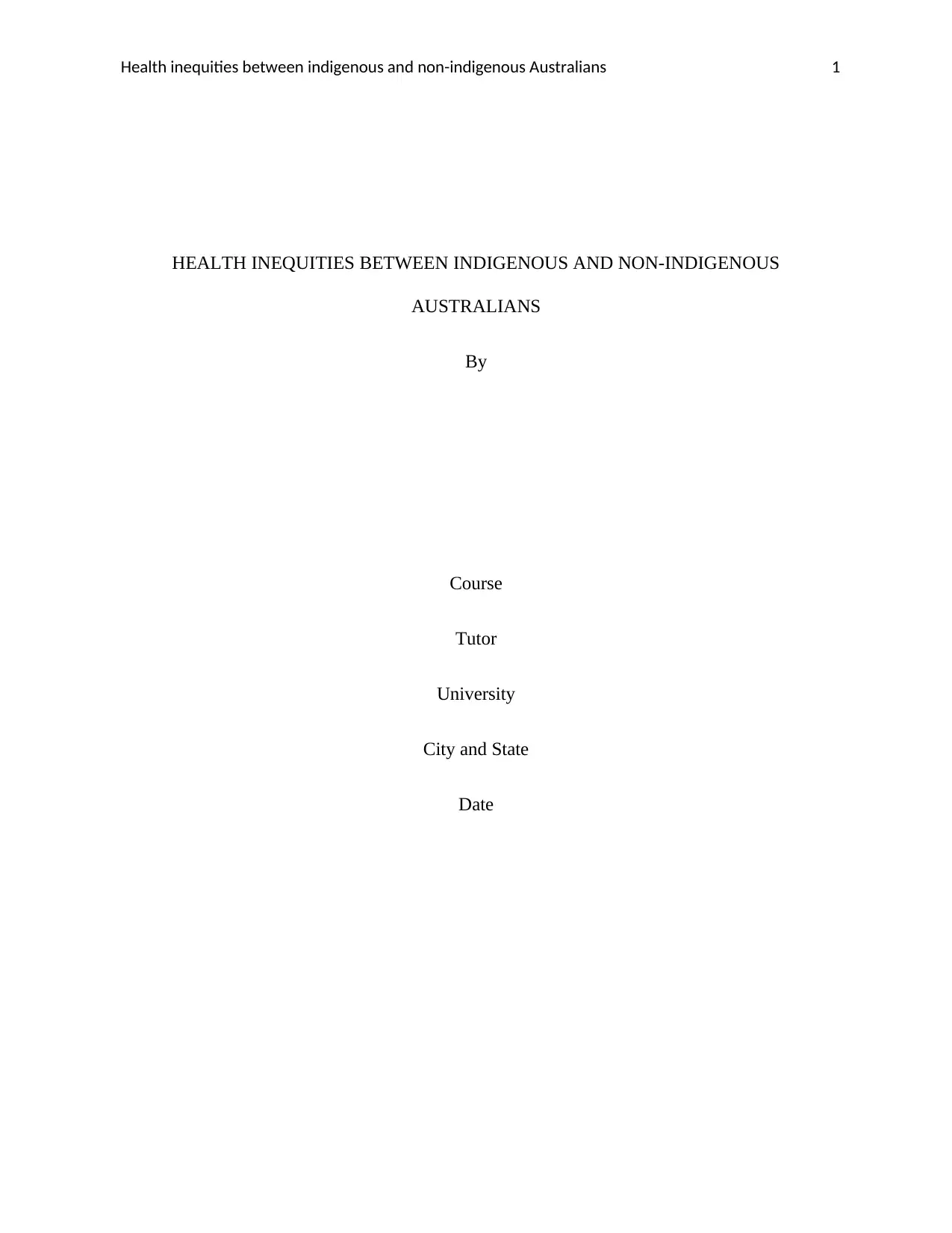
Health inequities between indigenous and non-indigenous Australians 1
HEALTH INEQUITIES BETWEEN INDIGENOUS AND NON-INDIGENOUS
AUSTRALIANS
By
Course
Tutor
University
City and State
Date
HEALTH INEQUITIES BETWEEN INDIGENOUS AND NON-INDIGENOUS
AUSTRALIANS
By
Course
Tutor
University
City and State
Date
Paraphrase This Document
Need a fresh take? Get an instant paraphrase of this document with our AI Paraphraser
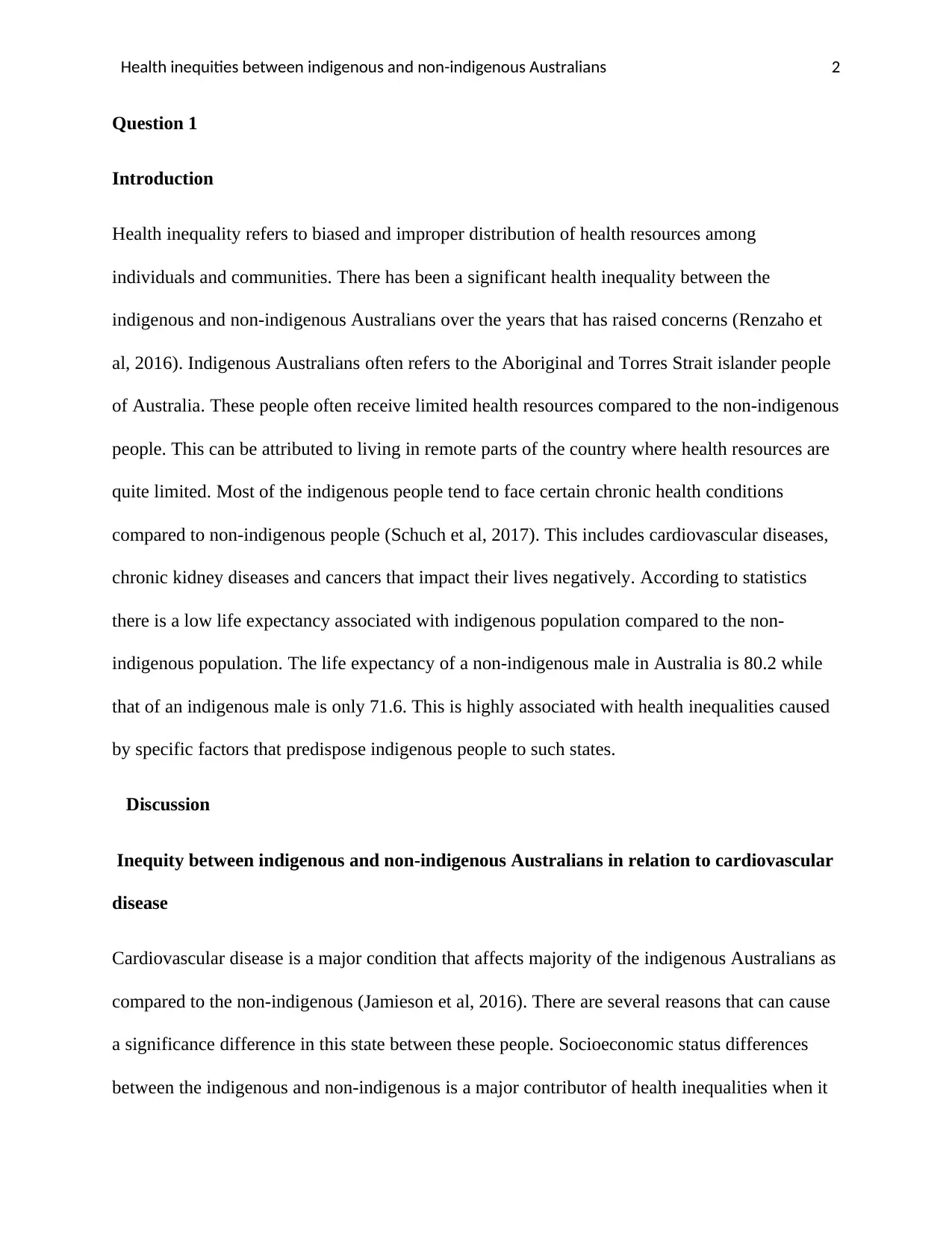
Health inequities between indigenous and non-indigenous Australians 2
Question 1
Introduction
Health inequality refers to biased and improper distribution of health resources among
individuals and communities. There has been a significant health inequality between the
indigenous and non-indigenous Australians over the years that has raised concerns (Renzaho et
al, 2016). Indigenous Australians often refers to the Aboriginal and Torres Strait islander people
of Australia. These people often receive limited health resources compared to the non-indigenous
people. This can be attributed to living in remote parts of the country where health resources are
quite limited. Most of the indigenous people tend to face certain chronic health conditions
compared to non-indigenous people (Schuch et al, 2017). This includes cardiovascular diseases,
chronic kidney diseases and cancers that impact their lives negatively. According to statistics
there is a low life expectancy associated with indigenous population compared to the non-
indigenous population. The life expectancy of a non-indigenous male in Australia is 80.2 while
that of an indigenous male is only 71.6. This is highly associated with health inequalities caused
by specific factors that predispose indigenous people to such states.
Discussion
Inequity between indigenous and non-indigenous Australians in relation to cardiovascular
disease
Cardiovascular disease is a major condition that affects majority of the indigenous Australians as
compared to the non-indigenous (Jamieson et al, 2016). There are several reasons that can cause
a significance difference in this state between these people. Socioeconomic status differences
between the indigenous and non-indigenous is a major contributor of health inequalities when it
Question 1
Introduction
Health inequality refers to biased and improper distribution of health resources among
individuals and communities. There has been a significant health inequality between the
indigenous and non-indigenous Australians over the years that has raised concerns (Renzaho et
al, 2016). Indigenous Australians often refers to the Aboriginal and Torres Strait islander people
of Australia. These people often receive limited health resources compared to the non-indigenous
people. This can be attributed to living in remote parts of the country where health resources are
quite limited. Most of the indigenous people tend to face certain chronic health conditions
compared to non-indigenous people (Schuch et al, 2017). This includes cardiovascular diseases,
chronic kidney diseases and cancers that impact their lives negatively. According to statistics
there is a low life expectancy associated with indigenous population compared to the non-
indigenous population. The life expectancy of a non-indigenous male in Australia is 80.2 while
that of an indigenous male is only 71.6. This is highly associated with health inequalities caused
by specific factors that predispose indigenous people to such states.
Discussion
Inequity between indigenous and non-indigenous Australians in relation to cardiovascular
disease
Cardiovascular disease is a major condition that affects majority of the indigenous Australians as
compared to the non-indigenous (Jamieson et al, 2016). There are several reasons that can cause
a significance difference in this state between these people. Socioeconomic status differences
between the indigenous and non-indigenous is a major contributor of health inequalities when it
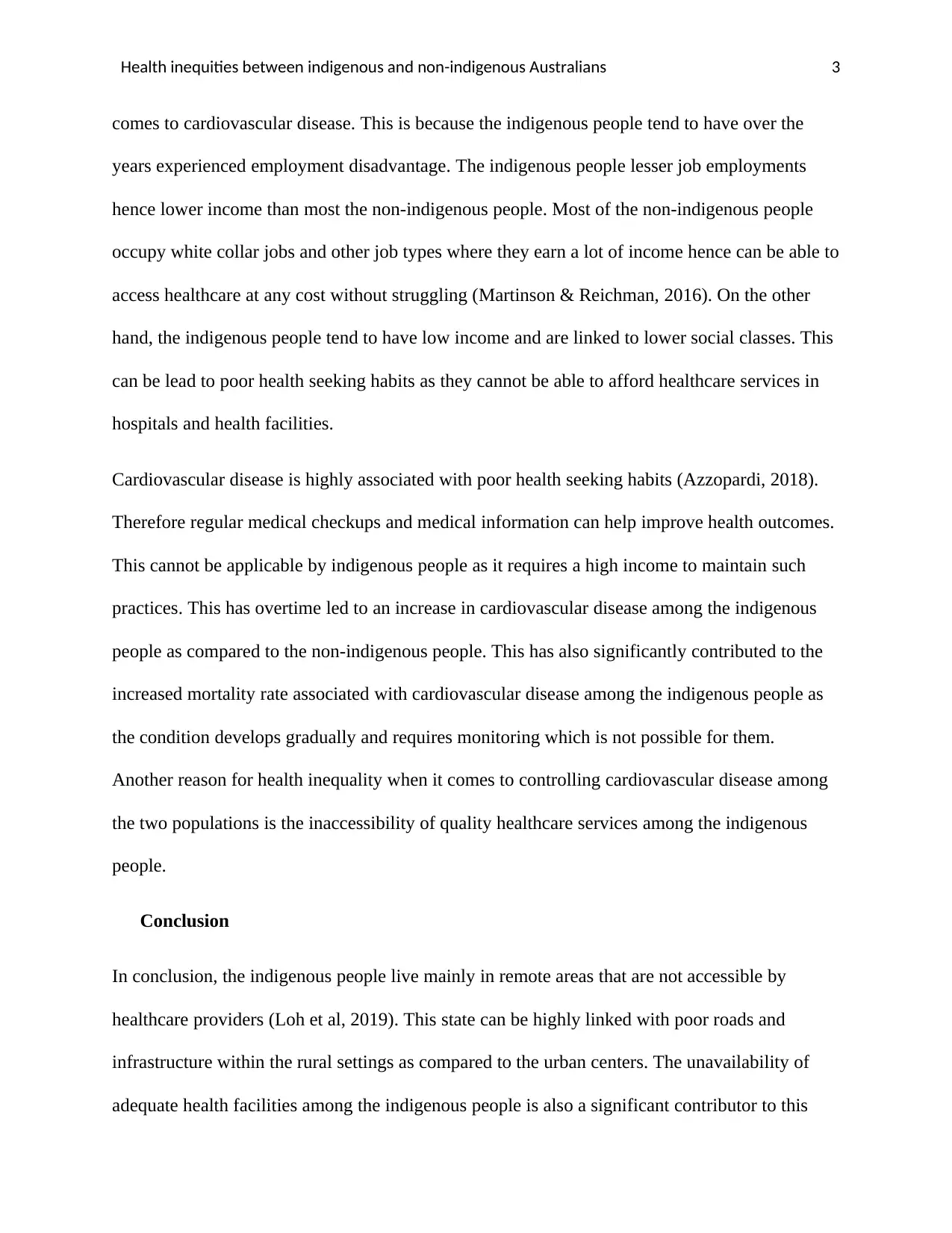
Health inequities between indigenous and non-indigenous Australians 3
comes to cardiovascular disease. This is because the indigenous people tend to have over the
years experienced employment disadvantage. The indigenous people lesser job employments
hence lower income than most the non-indigenous people. Most of the non-indigenous people
occupy white collar jobs and other job types where they earn a lot of income hence can be able to
access healthcare at any cost without struggling (Martinson & Reichman, 2016). On the other
hand, the indigenous people tend to have low income and are linked to lower social classes. This
can be lead to poor health seeking habits as they cannot be able to afford healthcare services in
hospitals and health facilities.
Cardiovascular disease is highly associated with poor health seeking habits (Azzopardi, 2018).
Therefore regular medical checkups and medical information can help improve health outcomes.
This cannot be applicable by indigenous people as it requires a high income to maintain such
practices. This has overtime led to an increase in cardiovascular disease among the indigenous
people as compared to the non-indigenous people. This has also significantly contributed to the
increased mortality rate associated with cardiovascular disease among the indigenous people as
the condition develops gradually and requires monitoring which is not possible for them.
Another reason for health inequality when it comes to controlling cardiovascular disease among
the two populations is the inaccessibility of quality healthcare services among the indigenous
people.
Conclusion
In conclusion, the indigenous people live mainly in remote areas that are not accessible by
healthcare providers (Loh et al, 2019). This state can be highly linked with poor roads and
infrastructure within the rural settings as compared to the urban centers. The unavailability of
adequate health facilities among the indigenous people is also a significant contributor to this
comes to cardiovascular disease. This is because the indigenous people tend to have over the
years experienced employment disadvantage. The indigenous people lesser job employments
hence lower income than most the non-indigenous people. Most of the non-indigenous people
occupy white collar jobs and other job types where they earn a lot of income hence can be able to
access healthcare at any cost without struggling (Martinson & Reichman, 2016). On the other
hand, the indigenous people tend to have low income and are linked to lower social classes. This
can be lead to poor health seeking habits as they cannot be able to afford healthcare services in
hospitals and health facilities.
Cardiovascular disease is highly associated with poor health seeking habits (Azzopardi, 2018).
Therefore regular medical checkups and medical information can help improve health outcomes.
This cannot be applicable by indigenous people as it requires a high income to maintain such
practices. This has overtime led to an increase in cardiovascular disease among the indigenous
people as compared to the non-indigenous people. This has also significantly contributed to the
increased mortality rate associated with cardiovascular disease among the indigenous people as
the condition develops gradually and requires monitoring which is not possible for them.
Another reason for health inequality when it comes to controlling cardiovascular disease among
the two populations is the inaccessibility of quality healthcare services among the indigenous
people.
Conclusion
In conclusion, the indigenous people live mainly in remote areas that are not accessible by
healthcare providers (Loh et al, 2019). This state can be highly linked with poor roads and
infrastructure within the rural settings as compared to the urban centers. The unavailability of
adequate health facilities among the indigenous people is also a significant contributor to this
⊘ This is a preview!⊘
Do you want full access?
Subscribe today to unlock all pages.

Trusted by 1+ million students worldwide
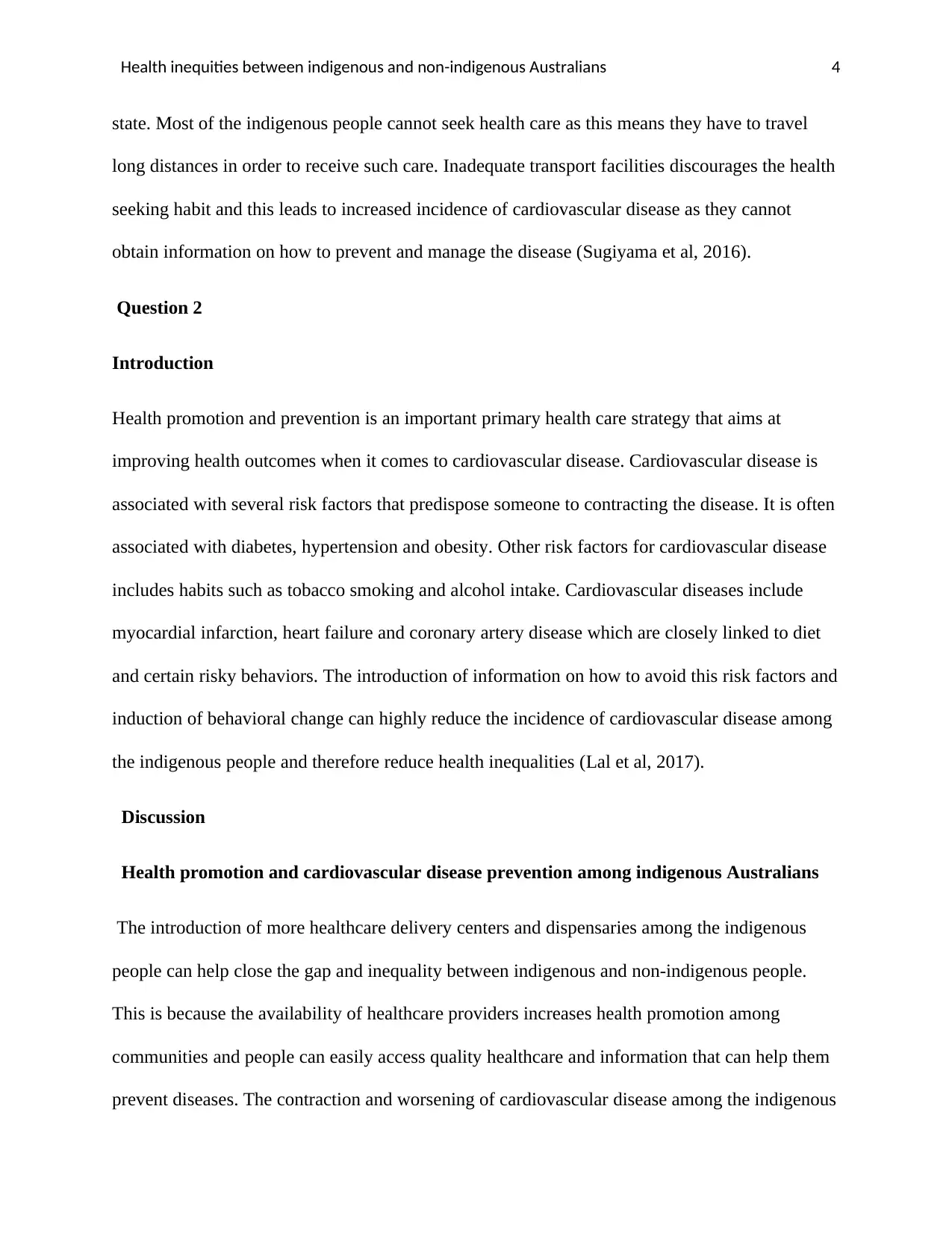
Health inequities between indigenous and non-indigenous Australians 4
state. Most of the indigenous people cannot seek health care as this means they have to travel
long distances in order to receive such care. Inadequate transport facilities discourages the health
seeking habit and this leads to increased incidence of cardiovascular disease as they cannot
obtain information on how to prevent and manage the disease (Sugiyama et al, 2016).
Question 2
Introduction
Health promotion and prevention is an important primary health care strategy that aims at
improving health outcomes when it comes to cardiovascular disease. Cardiovascular disease is
associated with several risk factors that predispose someone to contracting the disease. It is often
associated with diabetes, hypertension and obesity. Other risk factors for cardiovascular disease
includes habits such as tobacco smoking and alcohol intake. Cardiovascular diseases include
myocardial infarction, heart failure and coronary artery disease which are closely linked to diet
and certain risky behaviors. The introduction of information on how to avoid this risk factors and
induction of behavioral change can highly reduce the incidence of cardiovascular disease among
the indigenous people and therefore reduce health inequalities (Lal et al, 2017).
Discussion
Health promotion and cardiovascular disease prevention among indigenous Australians
The introduction of more healthcare delivery centers and dispensaries among the indigenous
people can help close the gap and inequality between indigenous and non-indigenous people.
This is because the availability of healthcare providers increases health promotion among
communities and people can easily access quality healthcare and information that can help them
prevent diseases. The contraction and worsening of cardiovascular disease among the indigenous
state. Most of the indigenous people cannot seek health care as this means they have to travel
long distances in order to receive such care. Inadequate transport facilities discourages the health
seeking habit and this leads to increased incidence of cardiovascular disease as they cannot
obtain information on how to prevent and manage the disease (Sugiyama et al, 2016).
Question 2
Introduction
Health promotion and prevention is an important primary health care strategy that aims at
improving health outcomes when it comes to cardiovascular disease. Cardiovascular disease is
associated with several risk factors that predispose someone to contracting the disease. It is often
associated with diabetes, hypertension and obesity. Other risk factors for cardiovascular disease
includes habits such as tobacco smoking and alcohol intake. Cardiovascular diseases include
myocardial infarction, heart failure and coronary artery disease which are closely linked to diet
and certain risky behaviors. The introduction of information on how to avoid this risk factors and
induction of behavioral change can highly reduce the incidence of cardiovascular disease among
the indigenous people and therefore reduce health inequalities (Lal et al, 2017).
Discussion
Health promotion and cardiovascular disease prevention among indigenous Australians
The introduction of more healthcare delivery centers and dispensaries among the indigenous
people can help close the gap and inequality between indigenous and non-indigenous people.
This is because the availability of healthcare providers increases health promotion among
communities and people can easily access quality healthcare and information that can help them
prevent diseases. The contraction and worsening of cardiovascular disease among the indigenous
Paraphrase This Document
Need a fresh take? Get an instant paraphrase of this document with our AI Paraphraser
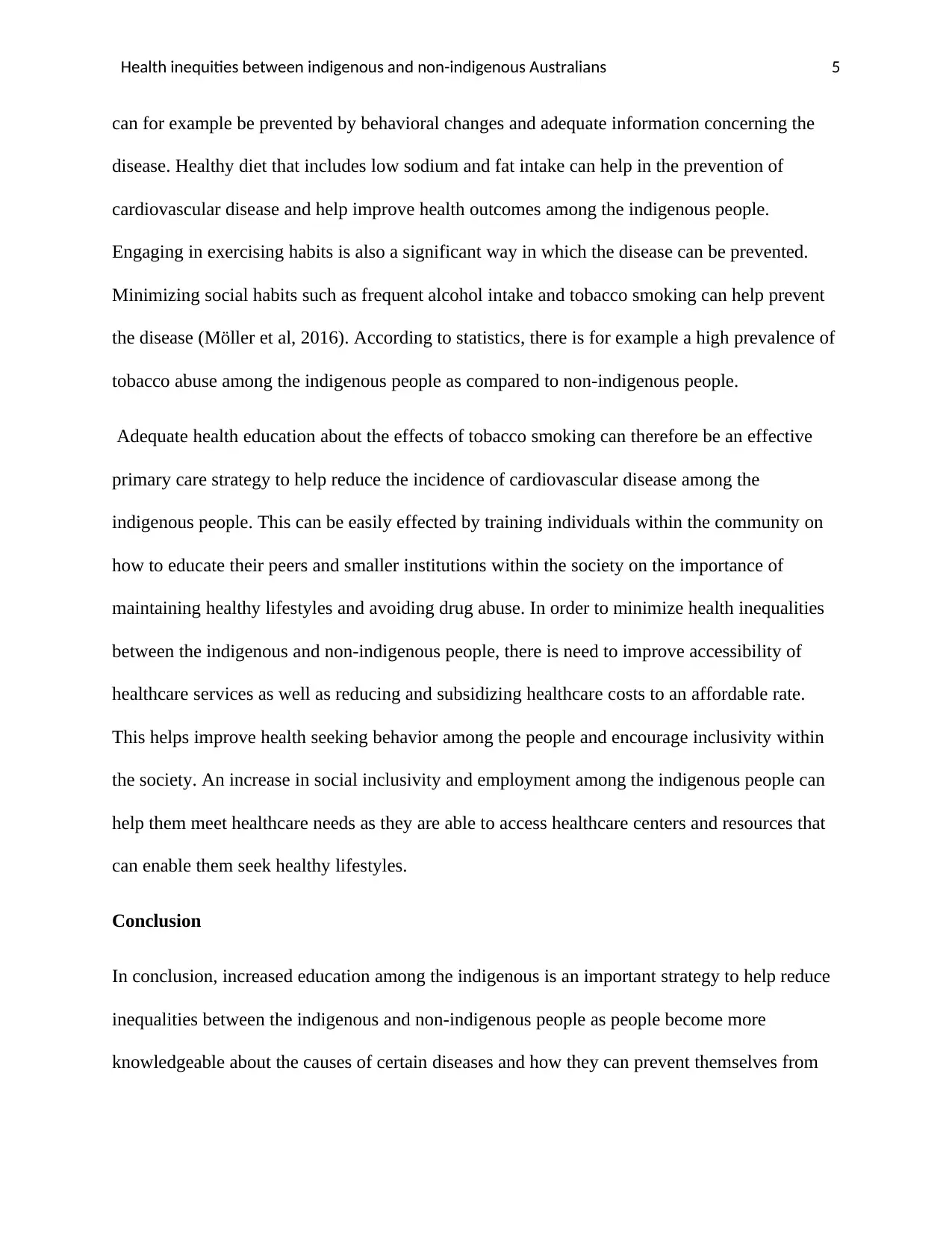
Health inequities between indigenous and non-indigenous Australians 5
can for example be prevented by behavioral changes and adequate information concerning the
disease. Healthy diet that includes low sodium and fat intake can help in the prevention of
cardiovascular disease and help improve health outcomes among the indigenous people.
Engaging in exercising habits is also a significant way in which the disease can be prevented.
Minimizing social habits such as frequent alcohol intake and tobacco smoking can help prevent
the disease (Möller et al, 2016). According to statistics, there is for example a high prevalence of
tobacco abuse among the indigenous people as compared to non-indigenous people.
Adequate health education about the effects of tobacco smoking can therefore be an effective
primary care strategy to help reduce the incidence of cardiovascular disease among the
indigenous people. This can be easily effected by training individuals within the community on
how to educate their peers and smaller institutions within the society on the importance of
maintaining healthy lifestyles and avoiding drug abuse. In order to minimize health inequalities
between the indigenous and non-indigenous people, there is need to improve accessibility of
healthcare services as well as reducing and subsidizing healthcare costs to an affordable rate.
This helps improve health seeking behavior among the people and encourage inclusivity within
the society. An increase in social inclusivity and employment among the indigenous people can
help them meet healthcare needs as they are able to access healthcare centers and resources that
can enable them seek healthy lifestyles.
Conclusion
In conclusion, increased education among the indigenous is an important strategy to help reduce
inequalities between the indigenous and non-indigenous people as people become more
knowledgeable about the causes of certain diseases and how they can prevent themselves from
can for example be prevented by behavioral changes and adequate information concerning the
disease. Healthy diet that includes low sodium and fat intake can help in the prevention of
cardiovascular disease and help improve health outcomes among the indigenous people.
Engaging in exercising habits is also a significant way in which the disease can be prevented.
Minimizing social habits such as frequent alcohol intake and tobacco smoking can help prevent
the disease (Möller et al, 2016). According to statistics, there is for example a high prevalence of
tobacco abuse among the indigenous people as compared to non-indigenous people.
Adequate health education about the effects of tobacco smoking can therefore be an effective
primary care strategy to help reduce the incidence of cardiovascular disease among the
indigenous people. This can be easily effected by training individuals within the community on
how to educate their peers and smaller institutions within the society on the importance of
maintaining healthy lifestyles and avoiding drug abuse. In order to minimize health inequalities
between the indigenous and non-indigenous people, there is need to improve accessibility of
healthcare services as well as reducing and subsidizing healthcare costs to an affordable rate.
This helps improve health seeking behavior among the people and encourage inclusivity within
the society. An increase in social inclusivity and employment among the indigenous people can
help them meet healthcare needs as they are able to access healthcare centers and resources that
can enable them seek healthy lifestyles.
Conclusion
In conclusion, increased education among the indigenous is an important strategy to help reduce
inequalities between the indigenous and non-indigenous people as people become more
knowledgeable about the causes of certain diseases and how they can prevent themselves from
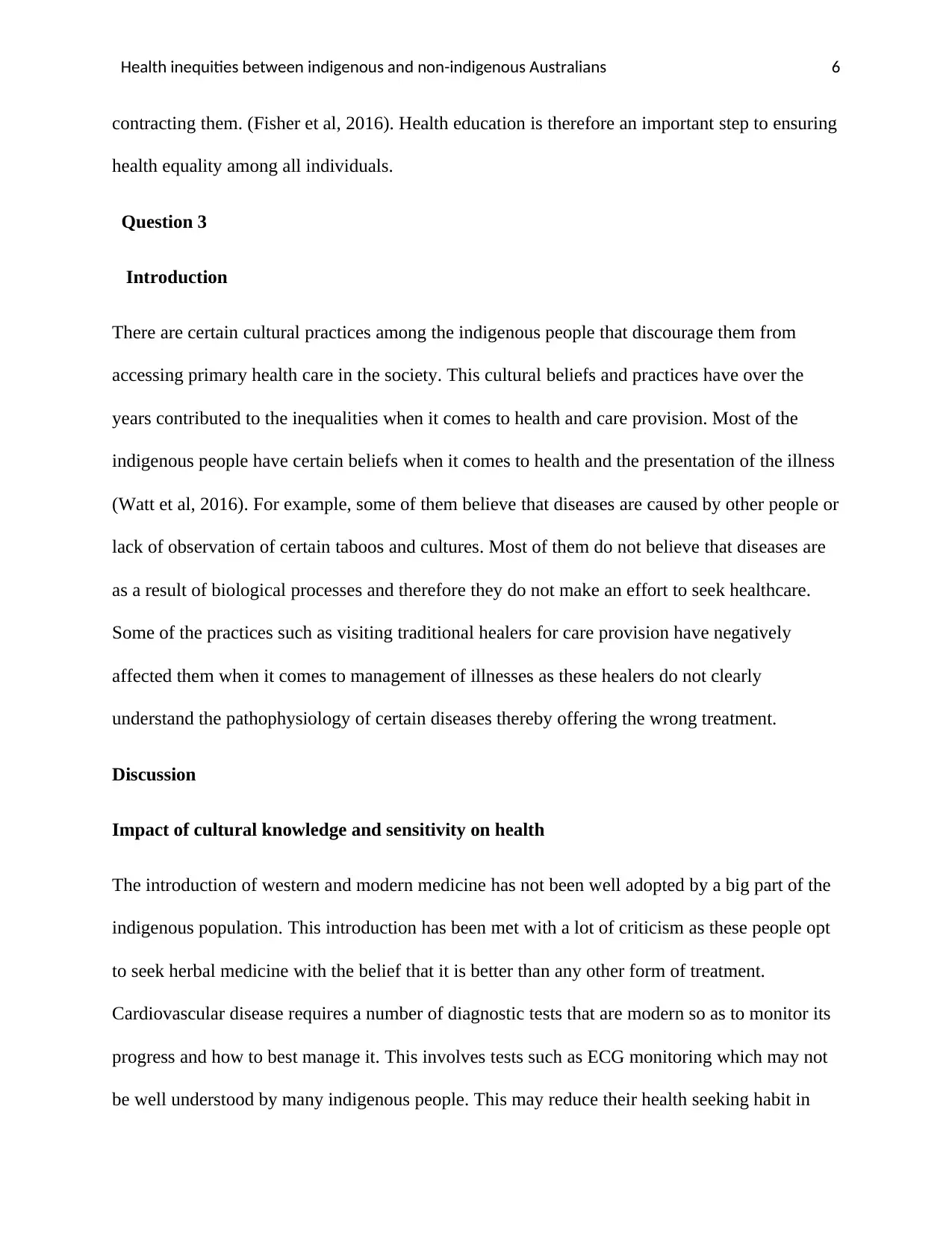
Health inequities between indigenous and non-indigenous Australians 6
contracting them. (Fisher et al, 2016). Health education is therefore an important step to ensuring
health equality among all individuals.
Question 3
Introduction
There are certain cultural practices among the indigenous people that discourage them from
accessing primary health care in the society. This cultural beliefs and practices have over the
years contributed to the inequalities when it comes to health and care provision. Most of the
indigenous people have certain beliefs when it comes to health and the presentation of the illness
(Watt et al, 2016). For example, some of them believe that diseases are caused by other people or
lack of observation of certain taboos and cultures. Most of them do not believe that diseases are
as a result of biological processes and therefore they do not make an effort to seek healthcare.
Some of the practices such as visiting traditional healers for care provision have negatively
affected them when it comes to management of illnesses as these healers do not clearly
understand the pathophysiology of certain diseases thereby offering the wrong treatment.
Discussion
Impact of cultural knowledge and sensitivity on health
The introduction of western and modern medicine has not been well adopted by a big part of the
indigenous population. This introduction has been met with a lot of criticism as these people opt
to seek herbal medicine with the belief that it is better than any other form of treatment.
Cardiovascular disease requires a number of diagnostic tests that are modern so as to monitor its
progress and how to best manage it. This involves tests such as ECG monitoring which may not
be well understood by many indigenous people. This may reduce their health seeking habit in
contracting them. (Fisher et al, 2016). Health education is therefore an important step to ensuring
health equality among all individuals.
Question 3
Introduction
There are certain cultural practices among the indigenous people that discourage them from
accessing primary health care in the society. This cultural beliefs and practices have over the
years contributed to the inequalities when it comes to health and care provision. Most of the
indigenous people have certain beliefs when it comes to health and the presentation of the illness
(Watt et al, 2016). For example, some of them believe that diseases are caused by other people or
lack of observation of certain taboos and cultures. Most of them do not believe that diseases are
as a result of biological processes and therefore they do not make an effort to seek healthcare.
Some of the practices such as visiting traditional healers for care provision have negatively
affected them when it comes to management of illnesses as these healers do not clearly
understand the pathophysiology of certain diseases thereby offering the wrong treatment.
Discussion
Impact of cultural knowledge and sensitivity on health
The introduction of western and modern medicine has not been well adopted by a big part of the
indigenous population. This introduction has been met with a lot of criticism as these people opt
to seek herbal medicine with the belief that it is better than any other form of treatment.
Cardiovascular disease requires a number of diagnostic tests that are modern so as to monitor its
progress and how to best manage it. This involves tests such as ECG monitoring which may not
be well understood by many indigenous people. This may reduce their health seeking habit in
⊘ This is a preview!⊘
Do you want full access?
Subscribe today to unlock all pages.

Trusted by 1+ million students worldwide
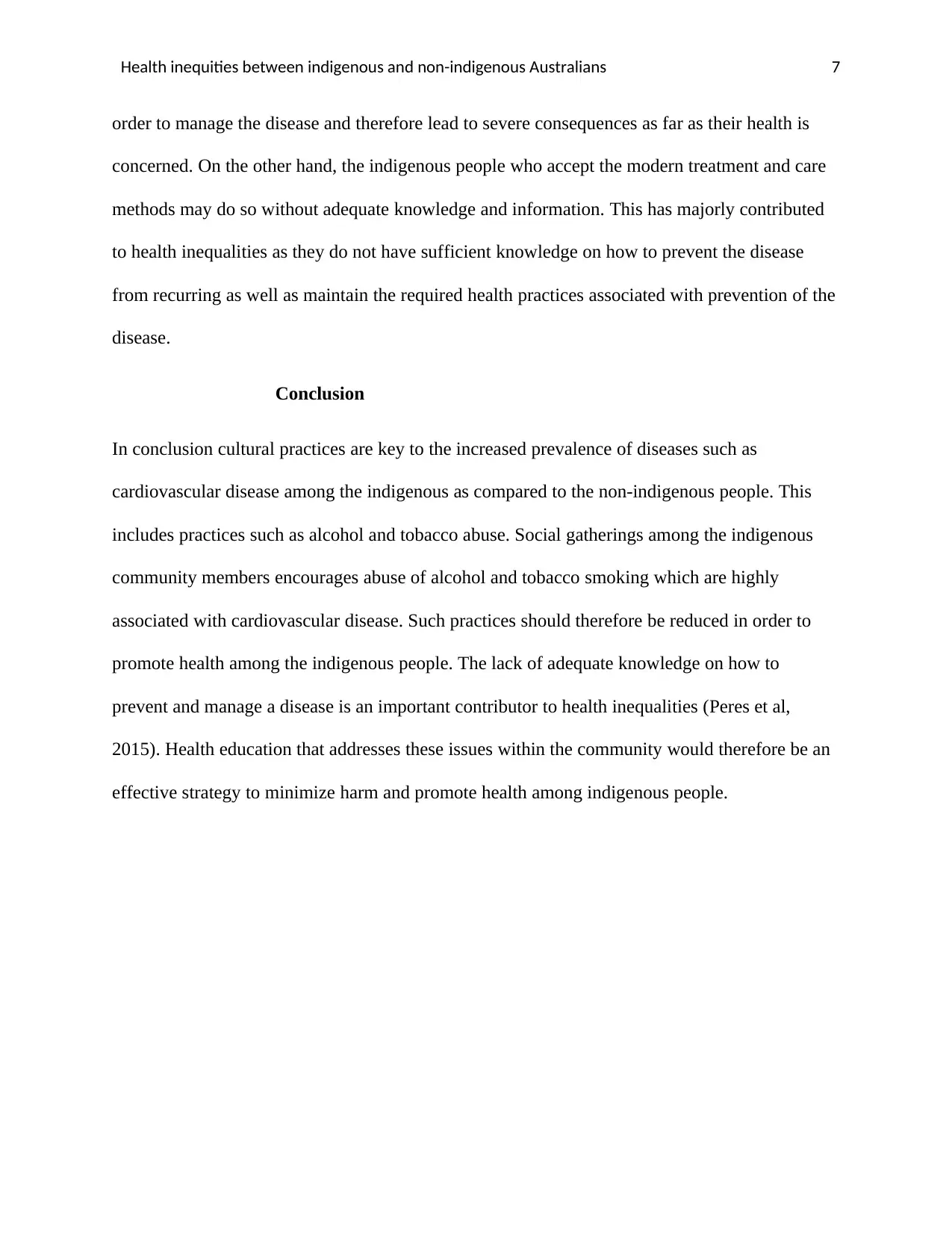
Health inequities between indigenous and non-indigenous Australians 7
order to manage the disease and therefore lead to severe consequences as far as their health is
concerned. On the other hand, the indigenous people who accept the modern treatment and care
methods may do so without adequate knowledge and information. This has majorly contributed
to health inequalities as they do not have sufficient knowledge on how to prevent the disease
from recurring as well as maintain the required health practices associated with prevention of the
disease.
Conclusion
In conclusion cultural practices are key to the increased prevalence of diseases such as
cardiovascular disease among the indigenous as compared to the non-indigenous people. This
includes practices such as alcohol and tobacco abuse. Social gatherings among the indigenous
community members encourages abuse of alcohol and tobacco smoking which are highly
associated with cardiovascular disease. Such practices should therefore be reduced in order to
promote health among the indigenous people. The lack of adequate knowledge on how to
prevent and manage a disease is an important contributor to health inequalities (Peres et al,
2015). Health education that addresses these issues within the community would therefore be an
effective strategy to minimize harm and promote health among indigenous people.
order to manage the disease and therefore lead to severe consequences as far as their health is
concerned. On the other hand, the indigenous people who accept the modern treatment and care
methods may do so without adequate knowledge and information. This has majorly contributed
to health inequalities as they do not have sufficient knowledge on how to prevent the disease
from recurring as well as maintain the required health practices associated with prevention of the
disease.
Conclusion
In conclusion cultural practices are key to the increased prevalence of diseases such as
cardiovascular disease among the indigenous as compared to the non-indigenous people. This
includes practices such as alcohol and tobacco abuse. Social gatherings among the indigenous
community members encourages abuse of alcohol and tobacco smoking which are highly
associated with cardiovascular disease. Such practices should therefore be reduced in order to
promote health among the indigenous people. The lack of adequate knowledge on how to
prevent and manage a disease is an important contributor to health inequalities (Peres et al,
2015). Health education that addresses these issues within the community would therefore be an
effective strategy to minimize harm and promote health among indigenous people.
Paraphrase This Document
Need a fresh take? Get an instant paraphrase of this document with our AI Paraphraser
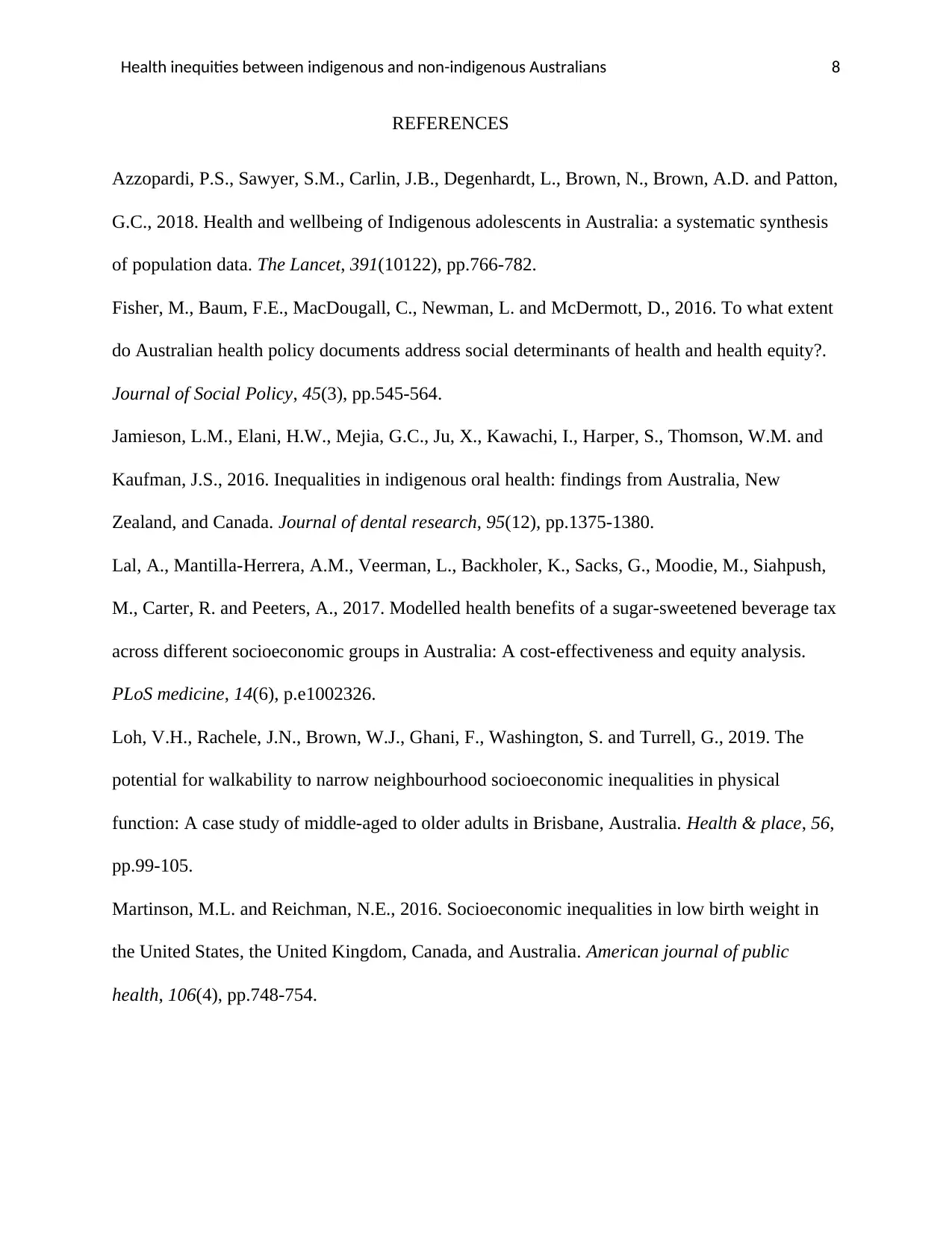
Health inequities between indigenous and non-indigenous Australians 8
REFERENCES
Azzopardi, P.S., Sawyer, S.M., Carlin, J.B., Degenhardt, L., Brown, N., Brown, A.D. and Patton,
G.C., 2018. Health and wellbeing of Indigenous adolescents in Australia: a systematic synthesis
of population data. The Lancet, 391(10122), pp.766-782.
Fisher, M., Baum, F.E., MacDougall, C., Newman, L. and McDermott, D., 2016. To what extent
do Australian health policy documents address social determinants of health and health equity?.
Journal of Social Policy, 45(3), pp.545-564.
Jamieson, L.M., Elani, H.W., Mejia, G.C., Ju, X., Kawachi, I., Harper, S., Thomson, W.M. and
Kaufman, J.S., 2016. Inequalities in indigenous oral health: findings from Australia, New
Zealand, and Canada. Journal of dental research, 95(12), pp.1375-1380.
Lal, A., Mantilla-Herrera, A.M., Veerman, L., Backholer, K., Sacks, G., Moodie, M., Siahpush,
M., Carter, R. and Peeters, A., 2017. Modelled health benefits of a sugar-sweetened beverage tax
across different socioeconomic groups in Australia: A cost-effectiveness and equity analysis.
PLoS medicine, 14(6), p.e1002326.
Loh, V.H., Rachele, J.N., Brown, W.J., Ghani, F., Washington, S. and Turrell, G., 2019. The
potential for walkability to narrow neighbourhood socioeconomic inequalities in physical
function: A case study of middle-aged to older adults in Brisbane, Australia. Health & place, 56,
pp.99-105.
Martinson, M.L. and Reichman, N.E., 2016. Socioeconomic inequalities in low birth weight in
the United States, the United Kingdom, Canada, and Australia. American journal of public
health, 106(4), pp.748-754.
REFERENCES
Azzopardi, P.S., Sawyer, S.M., Carlin, J.B., Degenhardt, L., Brown, N., Brown, A.D. and Patton,
G.C., 2018. Health and wellbeing of Indigenous adolescents in Australia: a systematic synthesis
of population data. The Lancet, 391(10122), pp.766-782.
Fisher, M., Baum, F.E., MacDougall, C., Newman, L. and McDermott, D., 2016. To what extent
do Australian health policy documents address social determinants of health and health equity?.
Journal of Social Policy, 45(3), pp.545-564.
Jamieson, L.M., Elani, H.W., Mejia, G.C., Ju, X., Kawachi, I., Harper, S., Thomson, W.M. and
Kaufman, J.S., 2016. Inequalities in indigenous oral health: findings from Australia, New
Zealand, and Canada. Journal of dental research, 95(12), pp.1375-1380.
Lal, A., Mantilla-Herrera, A.M., Veerman, L., Backholer, K., Sacks, G., Moodie, M., Siahpush,
M., Carter, R. and Peeters, A., 2017. Modelled health benefits of a sugar-sweetened beverage tax
across different socioeconomic groups in Australia: A cost-effectiveness and equity analysis.
PLoS medicine, 14(6), p.e1002326.
Loh, V.H., Rachele, J.N., Brown, W.J., Ghani, F., Washington, S. and Turrell, G., 2019. The
potential for walkability to narrow neighbourhood socioeconomic inequalities in physical
function: A case study of middle-aged to older adults in Brisbane, Australia. Health & place, 56,
pp.99-105.
Martinson, M.L. and Reichman, N.E., 2016. Socioeconomic inequalities in low birth weight in
the United States, the United Kingdom, Canada, and Australia. American journal of public
health, 106(4), pp.748-754.
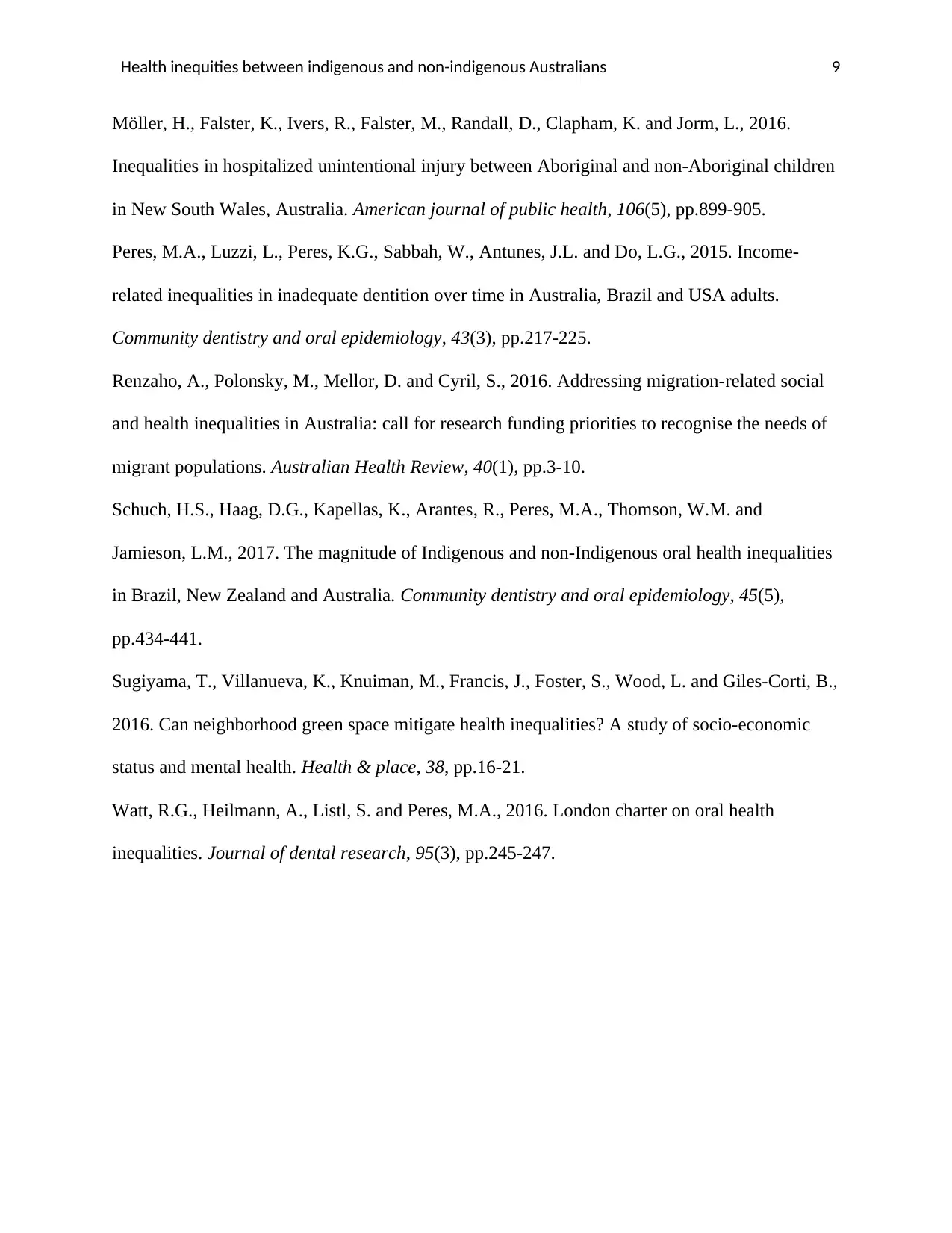
Health inequities between indigenous and non-indigenous Australians 9
Möller, H., Falster, K., Ivers, R., Falster, M., Randall, D., Clapham, K. and Jorm, L., 2016.
Inequalities in hospitalized unintentional injury between Aboriginal and non-Aboriginal children
in New South Wales, Australia. American journal of public health, 106(5), pp.899-905.
Peres, M.A., Luzzi, L., Peres, K.G., Sabbah, W., Antunes, J.L. and Do, L.G., 2015. Income‐
related inequalities in inadequate dentition over time in Australia, Brazil and USA adults.
Community dentistry and oral epidemiology, 43(3), pp.217-225.
Renzaho, A., Polonsky, M., Mellor, D. and Cyril, S., 2016. Addressing migration-related social
and health inequalities in Australia: call for research funding priorities to recognise the needs of
migrant populations. Australian Health Review, 40(1), pp.3-10.
Schuch, H.S., Haag, D.G., Kapellas, K., Arantes, R., Peres, M.A., Thomson, W.M. and
Jamieson, L.M., 2017. The magnitude of Indigenous and non‐Indigenous oral health inequalities
in Brazil, New Zealand and Australia. Community dentistry and oral epidemiology, 45(5),
pp.434-441.
Sugiyama, T., Villanueva, K., Knuiman, M., Francis, J., Foster, S., Wood, L. and Giles-Corti, B.,
2016. Can neighborhood green space mitigate health inequalities? A study of socio-economic
status and mental health. Health & place, 38, pp.16-21.
Watt, R.G., Heilmann, A., Listl, S. and Peres, M.A., 2016. London charter on oral health
inequalities. Journal of dental research, 95(3), pp.245-247.
Möller, H., Falster, K., Ivers, R., Falster, M., Randall, D., Clapham, K. and Jorm, L., 2016.
Inequalities in hospitalized unintentional injury between Aboriginal and non-Aboriginal children
in New South Wales, Australia. American journal of public health, 106(5), pp.899-905.
Peres, M.A., Luzzi, L., Peres, K.G., Sabbah, W., Antunes, J.L. and Do, L.G., 2015. Income‐
related inequalities in inadequate dentition over time in Australia, Brazil and USA adults.
Community dentistry and oral epidemiology, 43(3), pp.217-225.
Renzaho, A., Polonsky, M., Mellor, D. and Cyril, S., 2016. Addressing migration-related social
and health inequalities in Australia: call for research funding priorities to recognise the needs of
migrant populations. Australian Health Review, 40(1), pp.3-10.
Schuch, H.S., Haag, D.G., Kapellas, K., Arantes, R., Peres, M.A., Thomson, W.M. and
Jamieson, L.M., 2017. The magnitude of Indigenous and non‐Indigenous oral health inequalities
in Brazil, New Zealand and Australia. Community dentistry and oral epidemiology, 45(5),
pp.434-441.
Sugiyama, T., Villanueva, K., Knuiman, M., Francis, J., Foster, S., Wood, L. and Giles-Corti, B.,
2016. Can neighborhood green space mitigate health inequalities? A study of socio-economic
status and mental health. Health & place, 38, pp.16-21.
Watt, R.G., Heilmann, A., Listl, S. and Peres, M.A., 2016. London charter on oral health
inequalities. Journal of dental research, 95(3), pp.245-247.
⊘ This is a preview!⊘
Do you want full access?
Subscribe today to unlock all pages.

Trusted by 1+ million students worldwide
1 out of 9
Related Documents
Your All-in-One AI-Powered Toolkit for Academic Success.
+13062052269
info@desklib.com
Available 24*7 on WhatsApp / Email
![[object Object]](/_next/static/media/star-bottom.7253800d.svg)
Unlock your academic potential
Copyright © 2020–2025 A2Z Services. All Rights Reserved. Developed and managed by ZUCOL.





